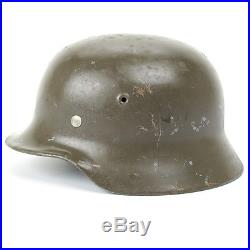
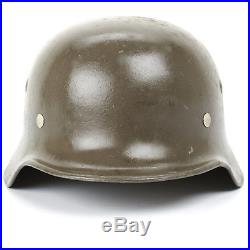
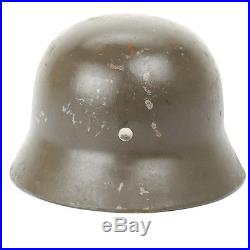
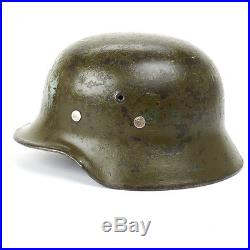
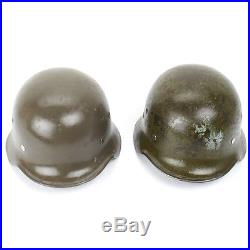
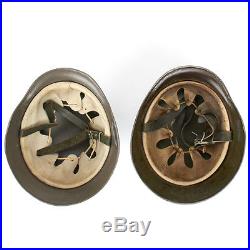
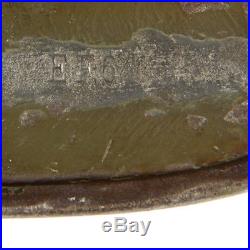
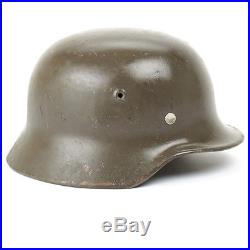
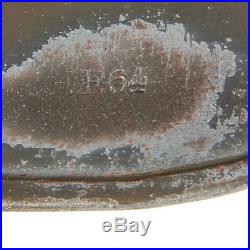
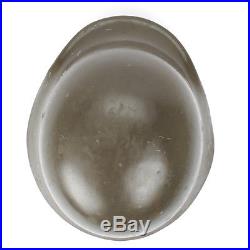

The world leader in military collectibles, military antiques and the militaria industry. Original German WWII M40 Stahlhelm Steel Helmet- Shell Size 64, Maker Marked. Finland imported thousands of German WW2 helmets for the Winter War of 1939-40 and the Continuation War of 1941-44. Since IMA acquired the last of all the known helmet stocks from the Finnish government we received a vast amount of the German WW2 marked helmets. This deal is a treasure trove of WWII era combat helmet history! The Finnish army used these helmets until the 1960s when they were taken out of service and put into military storage. Therefore, the provenance of these amazing nearly 75 year-old helmets cannot be disputed. Every German M40 helmet will be 100% original and will have the following notable features. &###x2022; Maker&###x2019;s code with size marking &###x201C;64&###x201D; stamped on the interior of the shell found over the wearer&###x2019;s left ear. Maker&###x2019;s codes vary (see chart below) all will be genuine WW2! &###x2022; Batch code found in rear of skirt (over wear&###x2019;s nape of neck). &###x2022; Rolled rim edge. &###x2022; Stamped ventilator holes. &###x2022; Genuine Military issue paint (most likely Finnish), colors vary. &###x2022; Finnish made leather liner with chinstrap, styles and colors vary. &###x2022; Helmet Shell Size is 64cm (liner size 57-58, US 7 1/8 – 7 1/4). What about original German decals? The Finnish government repainted all the helmets they imported from Germany. Have we found examples with original German decals under the paint? Yes, but the chance of you getting one is about 1/1000. What about original German M31 liners and chinstraps? The Finns used their own liner systems, some helmets we have found do have an original German M31 liner, but those have been sorted out and will be offered at another time. What is the difference between an M35, M40 and M42 helmet? An M35 helmet has a rolled rim around the edge of it. The air-vents are actually pressed-in grommet inserts. The M40 helmet substituted stamped air-vents for the pressed grommet air-vents but retained the rolled rim. The M42 has an unrolled rim to further cut time and machinery needs in helmet production. The M35 was produced until mid-1940 when the helmet manufacturers switched their tooling to produce the M40 version. During 1942 the specifications for a rolled rim were eliminated and manufacturers began switching to the M42 version. History of the German WW2 Helmet- Stahlhelm (plural Stahlhelme) is German for “steel helmet”. The Imperial German Army began to replace the traditional boiled leather Pickelhaube (spiked combat helmet) with the Stahlhelm during World War I in 1916. The term Stahlhelm refers both to a generic steel helmet, and more specifically to the distinctive (and iconic) German design. The Stahlhelm, with its distinctive “coal scuttle” shape, was an instantly recognizable icon for military imagery and became a common element of military propaganda on both sides, just like the Pickelhaube before it. WW2 Helmet Models- M1935 In 1934 tests began on an improved Stahlhelm, whose design was a development of World War I models. The Eisenh&###xFC;ttenwerke company of Thale carried out prototype design and testing, with Dr. The new helmet was pressed from sheets of molybdenum steel in several stages. The size of the flared visor and skirt was reduced, and the large projecting lugs for the obsolete armor shield were eliminated. The ventilator holes were retained, but were set in smaller hollow rivets mounted to the helmet’s shell. The edges of the shell were rolled over, creating a smooth edge along the helmet. Finally, a completely new leather suspension, or liner, was incorporated that greatly improved the helmet’s safety, adjustability, and comfort for each wearer. These improvements made the new M1935 helmet lighter, more compact, and more comfortable to wear than the previous designs. The Army’s Supreme Command officially accepted the new helmet on June 25, 1935 and it was intended to replace all other helmets in service. Over 1 million M1935 helmets were manufactured in the first two years after its introduction, and millions more were produced until 1940 when the basic design and production methods were changed. M1940 The M1935 design was slightly modified in 1940 to simplify its construction; the manufacturing process now incorporating more automated stamping methods. The principal change was to stamp the ventilator hole mounts directly onto the shell, rather than utilizing separate fittings. In other respects, the M1940 helmet was identical to the M1935. The Germans still referred to the M1940 as the M1935, while the M1940 designation were given by collectors. M1942 The M1942 design was a result of wartime demands. The rolled edge on the shell was eliminated, creating an unfinished edge along the rim. This edge slightly flared out, along the base of the skirt. The elimination of the rolled edge expedited the manufacturing process and reduced the amount of metal used in each helmet. Shell paint colors towards the end of the war typically ran to matte gray-green, and the decals were gradually eliminated to speed up production and reduce the helmet’s combat visibility. Greater manufacturing flaws were also observed in M42 helmets made late in the war. WW2 German Helmet Manufactures Shell Markings- In virtually all WWII German helmets you will also see the size stamp after the Manufacturing mark, such as Q66. In this case, you have a helmet manufactured by the Quist firm, size 66 cm. The sizes ran from very small of 60 cm, up to 70 cm. The majority of the WWII German helmets were manufactured in size 62, 64, and 66. Size 60 helmets as well as size 70 helmets are nearly impossible to find. Below is a list of the five manufactures of German WW2 Helmets with their respective markings and factory locations. Marking, Manufacturing Firm, City (FS or EF), Emaillierwerke AG, Fulda, Germany. (ET or ckl), Eisenhuttenwerke, Thale, Germany. (Q)- Quist, Esslingen, Germany. (NS)- Vereinigte Deutsche Nikelwerke, Schwerte, Germany. (SE or hkp)- Sachsische Emaillier u. Stanzwerke, Lauter, Germany (Source: Baer, 1995). More than 25 Million German combat helmets were manufactured during the Second World War. Five independently owned metal fabrication plants accomplished this massive effort with experience in steel production. The largest producer of steel helmets (Stahlhelme) was the firm of Eisenh&###xFC;ttenwerke located in the city of Thale. The Thale firm and its engineers played a major role in the initial design and prototyping of the M1935 steel combat helmet. Production records indicate that nearly 20 Million helmets were manufactured between early 1939 and May 1944. Beginning as early as 1935, manufacturers began marking their helmet shells with the initials of the factory or company names. Over the course of time, several of these changed making it initially appear as though there were more than five manufacturers. The change in the factory designated name and marking had to do with the fact that the company names changed. These factory names were stamped directly into the helmet shell using two or three letters. Next to the letters was stamped the metric shell size of the helmet. In addition to these markings, helmets also received a stamped number in the rear center of the helmet’s flange or skirt. This second set of numbers indicated the production number of the entire lot to which the helmet could be attributed. In some cases, the Quist firm also produced helmets bearing a “DN” stamp in the same location. The “DN” referred to the patent identification associated with the helmet’s model or type. It should be noted that on occasion a helmet might be found bearing no markings whatsoever. If the helmet is a wartime shell, the explanation generally falls into to possibilities. The first is that the markings are there but shallow or buried beneath a thick coat of paint. The second relates to the fact that some helmets do not appear to have been marked at all. This may be related to a factory error, or something done intentionally. No clear rational has been found to explain this uncommon occurrence. Wartime manufactured German combat helmets were stamped with an alpha-numeric code under the flared rim of the helmet (often referred to as the skirt). This was done in order to help identify the shell size and maker. These markings were always placed in one of two places; the center of the left underside rim or the center rear of the skirt. This alpha-numeric code contained both the maker’s initials and the metric shell size of the helmet in a single line. These markings were placed on all helmets made during World War II. The numbers denoting the maker’s mark and shell size were was placed on the left side of the helmet under the flared skirt. The firm of Quist moved their maker’s marks to the rear of the helmet sometime during 1942 or 1943. These marks remained in that location for the duration of the war. In addition to the factory maker code markings, a second set of stamps were placed into the shell to denote which production run (or lot number) the helmet had come from. Virtually all wartime manufactured helmets have the production run number stamped into the shell. Only a handful of helmets do not and the reason for this remains unknown. Combat helmets show the markings at the rear of the helmet as do civic model helmets used by non-combat related organizations. The production run number generally took the form of three or four digits representing the production run that a given helmet came from. The production run number is sometimes referred to as a “lot number” or more specifically a serial number. ” Occasionally helmets were also stamped with a “DN above the production code at the back of the skirt. The “DN” was a patent mark that indicated that the helmet was manufactured in Germany. German wartime era helmets did not receive any shell stamping marks other than those described here. History the German & Finnish Alliance- In 1938 Finland became very concerned with Stalin’s Soviet expansionism and turned to Great Britain and France for support. Both Countries were under supplied themselves so Finland, perhaps reluctantly turned to Nazi Germany for aid. Hitler was swift to assist supplying great quantities of materiel including thousands of German Battle Helmets. The Russians invaded Finland in 1939 driving deep into the country. The Finns resisted with amazing tenacity that has been the subject of legend and the wonderful WW2 Movie “THE WINTER WAR” (offered by IMA). The Russians paid a very heavy price and sued for peace in early 1940 keeping the invaded areas of Finland. Finland totally exhausted agreed with great regret. In the summer of 1941 Hitler&###x2019;s Nazi War Machine invaded the Soviet Union driving everything before them. Finland whom had received so much help from Germany then rose up and drove the Soviet presence out of Finland. However Finland would not “invade” the Soviet Union, they declared themselves not to be aggressors. It is true however that the Germans recruited great numbers of Finnish “Volunteers” for their “SS UNITS” that did invade Mother Russia but that was true of all the overrun European Countries and even some others, still independent including apparently England and the United States, although these number were said to be very low. At the close of WW2 with Germany defeated Finland was highly penalized by the Soviet Union, again gave up the lost territory of 1939/40 but did manage to retain it’s independence unlike so much of Eastern Europe. WHAT YOU SEE IS NOT WHAT YOU GET! We display multiple images and write detailed descriptions of the products we sell in order to provide the customer with as much information as possible so you know what to expect when you open the box. However, most of our original antique items are not one-of-a-kind. Meaning the images you are viewing will not be the exact item that you will receive when you place your order. The images will, however, represent a typical example. In fact, the photos of products displayed on the website are never the very best examples of what we have. We make a concerted effort to photograph average examples of each product. This way, you can expect to receive an item that is at lest as good as the one photographed, unless specified otherwise. The only time you will get the exact item photographed is when an item is listed as &###x201C;one only&###x201D; or &###x201C;one-of-a-kind&##x201D. However, because so much of what we sell is original antique merchandise there will be some differences between anything photographed and what you receive. Differences are generally minor and can include; markings, dates, size, color, overall condition and more. IMA Inc was founded by Christian Cranmer in 1981. In 2004, his son Alexander joined the business and together (with plenty of help from their magnificent staff) have grown IMA to become the world leader of the Military Collectibles, Military Antiques and the Militaria industry. We offer thousands of military antique items, including very rare original pieces spanning the past five centuries, as well as hard to find top quality new made reproductions. IMA supplied some of the world’s foremost Military Museums, Film Productions (Saving Private Ryan), Collectors, and Re-enactors. However, most IMA customers are just everyday people that happen to share our passion for history. We are an American company with European roots. Our corporate offices are located in Gillette, New Jersey, less than one hour from New York City. Thank you very much for visiting. Please allow us the opportunity to resolve problems; we understand the concern and frustration you may have and will do our very best to resolve any and all issues. We want to make it easy. You DO NOT need a Return Authorization Number (RA#). Unaltered Condition means that no restoration, painting, major cleaning, or change of any kind has occurred. The return address label provided by IMA is not pre-paid. It is only an adhesive label with our correct address. We appreciate your patience and understanding. Be sure to include a brief note telling us your name, order number (if you have it), explanation as to why you are returning your item. We will resolve your issue before either option is required- that is a promise. We will notify UPS about a pending claim. (UPS rules, not ours). UPS claims can take up to four weeks, but typically are resolved sooner. We also maintain a secure database of customer addresses. If a mistake was made and IMA is responsible, we will correct it out of our cost. Add to Favorite Sellers. Sign up to Newsletter. View more great items. This listing is currently undergoing maintenance, we apologise for any inconvenience caused. The item “Original German WWII M40 Stahlhelm Steel Helmet- Shell Size 64, Maker Marked” is in sale since Friday, September 05, 2014. This item is in the category “Collectibles\Militaria\WW II (1939-45)\Original Period Items\Germany\Hats & Helmets”. The seller is “international-military-antiques” and is located in Gillette, New Jersey. This item can be shipped to United States.
